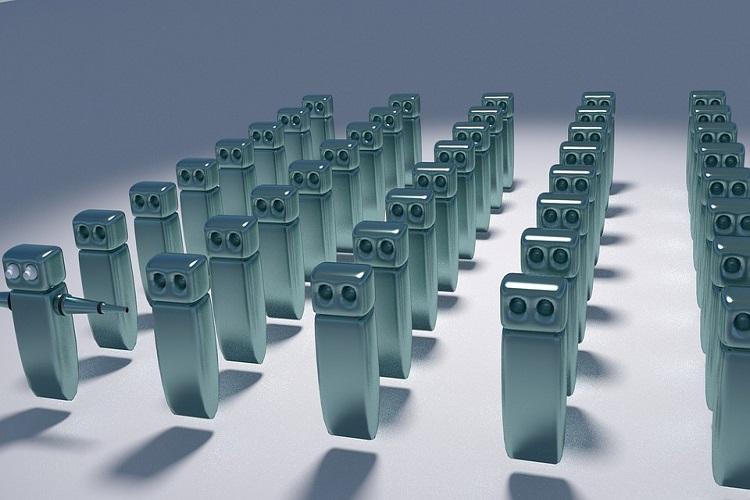
Global spending on robotics and drones solutions will reach USD 201.3 billion in 2022 and achieve a compound annual growth rate (CAGR) of 19.6% over the 2017-2022 forecast period, according to IDC’s Worldwide Semiannual Robotics and Drones Spending Guide. Robotics and drone spending will reach USD 95.9 billion in 2018.
Spending on robotics solutions will total USD 86.6 billion in 2018 and will account for more than 85% of all spending throughout the five-year forecast. Industrial robotic solutions will account for the largest share of robotics spending (more than 57%), followed by service robots and consumer robots. Discrete and process manufacturing will be the leading industries for robotics spending at more than USD 54 billion combined in 2018. The resource and healthcare industries will also make significant investments in robotics solutions this year. The retail and wholesale industries will see the fastest robotics spending growth over the forecast with CAGRs of 32.7% and 30.7%, respectively.
"Collaborative robots are taking off in industrial applications, driven by customer demands for product quality, delivery, and mass customization," said Dr. Jing Bing Zhang, research director, Worldwide Robotics. "While being safe is the prerequisite for any collaborative robot, the market is already shaping the development of collaborative robots towards simplicity, smartness, and ease of redeployment."
Worldwide drone spending will be USD 9.3 billion in 2018 and is expected to grow at a faster rate than the overall market with a five-year CAGR of 32.1%. Enterprise drone solutions will deliver more than half of all drone spending throughout the forecast period with the balance coming from consumer drone solutions. Enterprise drones will increase its share of overall spending with a five-year CAGR of 37.1%. The utilities and construction industries will see the largest drone spending in 2018 (USD 925 million and USD 808 million, respectively), followed by the process and discrete manufacturing industries. Key growth in drone spending will come from various industries including education (72.8% CAGR) and federal/central government (70.1% CAGR).
"Organizations continue to explore a range of applications and use cases for drones, moving beyond aerial photography to drone-based deliveries, precision agriculture monitoring, and even time-sensitive medical deliveries. With these expanded use cases come concerns across many governing parties. Most regions, however, are starting to provide regulatory clarity, as they understand the growing need for drone control and an air traffic management system for both enterprise and consumer deployments. In addition, as safety continues to be a major concern for consumers and regulators, vendors and IT suppliers are working to alleviate concerns by building drones with multiple redundancies, improving their sensory and collision avoidance technology, and testing 5G-enabled drones to enable greater connectivity while lowering latency. The sky's the limit," said Stacey Soohoo, research manager, IDC's Customer Insights & Analysis.
The use cases that will capture the largest share of robotics and drones spending are driven by their respective industries. As the primary use case in the Discrete Manufacturing industry for robotics, welding is forecast to receive over 15% of all robotics spending worldwide throughout the forecast. Other robotics use cases that will drive spending include assembly, painting, mixing, automated production in mining, and pick and pack. The use cases that will see the fastest growth in robotics spending over the forecast period include break bulk (53.4% CAGR), shelf stocking (45.6% CAGR), and customer service (42.0% CAGR). For drones, the use cases that will see the fastest growth over the forecast period include dispensing pesticides and fertilizer (109.4% CAGR), emergency service (86.4% CAGR) and precision agriculture/crop scouting (86.1% CAGR).

More than half of all robotics spending this year (USD 58.1 billion) and throughout the forecast will go to robotics systems, after-market robotics hardware, and systems hardware. Services-related spending, which encompasses application management, education & training, hardware deployment and support, systems integration, and others will total more than USD 16.7 billion in 2018 while spending on command and control, specific robotics applications, and network infrastructure software will reach USD 11.8 billion. Purchases of drones and after-market drone hardware will be nearly USD 7.9 billion in 2018 while spending on command and control, specific drone applications, and network infrastructure software will reach USD 611 million.
On a geographic basis, China will be the largest geographic market for robotics, delivering more than 30% of all robotics spending throughout the forecast, followed by the rest of Asia/Pacific (excluding China and Japan), the United States, and Japan. The United States will be the largest geographic market for drone spending at USD 4.3 billion in 2018, followed by Western Europe and China. However, exceptionally strong spending growth in China (63.2% CAGR) will move this market ahead of the United States by 2022.

 In
In
Comments
Amoxicillin Side Effect Spasm
Amoxicillin Side Effect Spasm https://abcialisnews.com/ - Cialis Male Horse Tonic For Men <a href=https://abcialisnews.com/#>cialis daily</a> Will Keflex Treat Mrsa
Add new comment